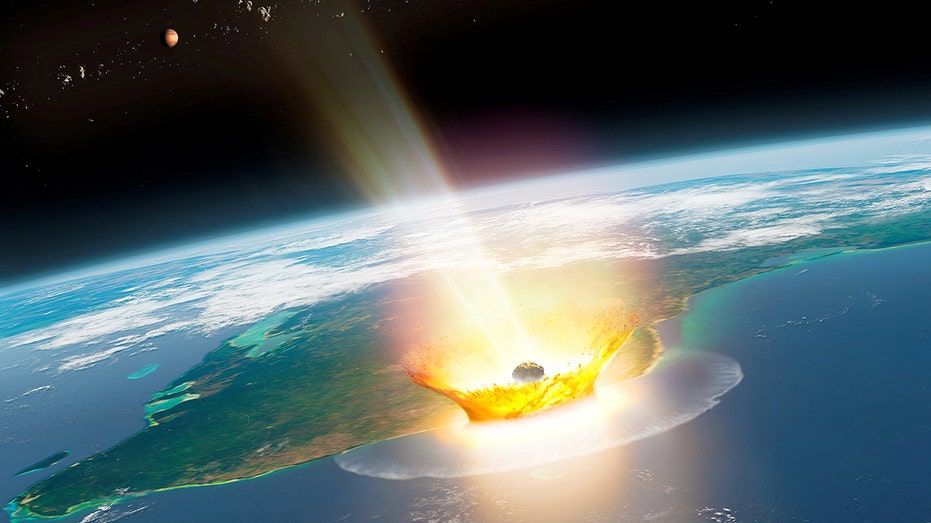Scientists in Albuquerque, New Mexico, say potentially dangerous asteroids could possibly be deflected by exploding a nuclear warhead more than a mile from its surface and showering it with X-rays to send it in a different direction.
Previous methods, as seen in blockbuster movies like “Armageddon” and “Deep Impact,” involved blowing up a nuclear warhead on an asteroid or comet and shattering it into multiple pieces.
But scientists now say the method would change the space object from a lethal bullet headed toward Earth into a shotgun blast of multiple fragments.
Last year, the National Academy of Sciences released a report calling planetary defense a national priority, and according to an ongoing NASA sky survey, the threat is credible.

The sky survey found there are about 25,000 objects big enough to cause varying degrees of destruction to Earth, and only about a third of them have been detected and tracked, according to a press release from the Sandia National Laboratories in Albuquerque.
Many of the objects move invisibly in the sun’s glare. In 2013, a relatively small object created chaos in Russia while a larger asteroid is credited with ending the age of dinosaurs.
“To most people, the danger from asteroids seems remote,” Nathan Moore, a physicist at Sandia National Laboratories said. “But our planet is hit by BB-sized asteroids every day. We call them shooting stars. We don’t want to wait for a large asteroid to show up and then scramble for the right method to deflect it.”
Moore’s team conducted several experiments with Sandia’s Z machine, the most powerful pulsed-power machine on Earth, to monitor the deflection of synthetic asteroids hit by Z’s sudden shocks.
FLASHBACK: STUDY SAYS ASTEROID THAT KILLED THE DINOSAURS ALSO CAUSED A GLOBAL TSUNAMI

While the machine is on Earth, all experiments are affected by gravity, though Moore’s team was able to beat the inevitable force temporarily to create a better simulation of asteroids floating freely in space.
Moore’s experiments used a technique called X-ray scissors, which removed the skewing effect of friction and gravity for a few microseconds.
The X-ray scissors allowed the model to create the effect of redirecting a free-floating asteroid when hit by a series of nuclear-intensity explosions.
Although the experiments were done in a much smaller environment than space, they could be scaled to predict the effects of nuclear explosions on an actual asteroid.
DINOSAUR-KILLING ASTEROID LIKELY CAME FROM BEYOND JUPITER, STUDY FINDS

“I started working through the logic of how I could deflect a miniature asteroid in a laboratory just like in outer space,” Moore said. “A key fact was that asteroids in outer space aren’t attached to anything. But in a lab, everything is pulled down by Earth’s gravity, so everything is held in place by its gravitational attachment to something else. This wouldn’t let our mock asteroid move with the freedom of one in outer space. And mechanical attachments would create friction that would perturb the mock asteroid’s motion.”
And that’s where the X-ray scissors came in. The method allowed scientists to release a mock asteroid the size of a tenth of a gram and made of silica, into the free space vacuum.
The material was suspended by foil eight times thinner than human hair, which vaporized instantly when the Z machine fired.
The silica was then left free-floating as the X-ray burst hit it.
NASA COLLISION WITH ASTEROID DIMORPHOS CHANGED BOTH ITS TRAJECTORY AND SHAPE

“It was a novel idea,” Moore said. “A mock asteroid is suspended in space. For a one-nanometer fall, we can ignore Earth’s gravity for 20 millionths of a second as Z produces a burst of X-rays that sweeps over the mock-asteroid surface 12.5 millimeters across, about the width of a finger.
“The trick is to use just enough force to redirect the flying rock without splitting it into several equally deadly subsections advancing toward Earth,” Moore added, referring to a real intercept scenario like the recent NASA DART experiment.
The news comes just days after NASA monitored a “potentially hazardous” asteroid moving past Earth last Tuesday.
NASA told Fox News Digital that the rocky object, which has been named 2024 ON, is 350 meters long by 180 meters wide, which roughly equals 1,150 feet by 590 feet — larger than previous estimates.
NASA has deemed the asteroid “stadium-sized” and reported it was 621,000 miles away from Earth, which is considered relatively close. Davide Farnocchia, a navigation engineer at NASA’s Jet Propulsion Laboratory, told Fox News Digital that an asteroid of this size coming this close to Earth only happens every five to ten years.
CLICK HERE TO GET THE FOX NEWS APP
Although the asteroid was close enough to Earth to be deemed a “potentially hazardous object,” Farnocchia said there is no chance the asteroid would hit Earth. The asteroid would need to be within a couple of hundred miles to be a concern.
The asteroid was one of five that would pass by Earth last week, but the other rocky objects were not expected to come nearly as close as 2024 ON. The four asteroids were between 1.1 to 3.9 million miles away from Earth, and three of the asteroids measured roughly 51 feet in diameter, which is the size of a house.
Fox News Digital’s Andrea Vacchiano contributed to this report.
Daily Science News on Fox News
Read the full article .


